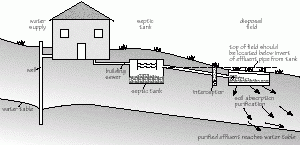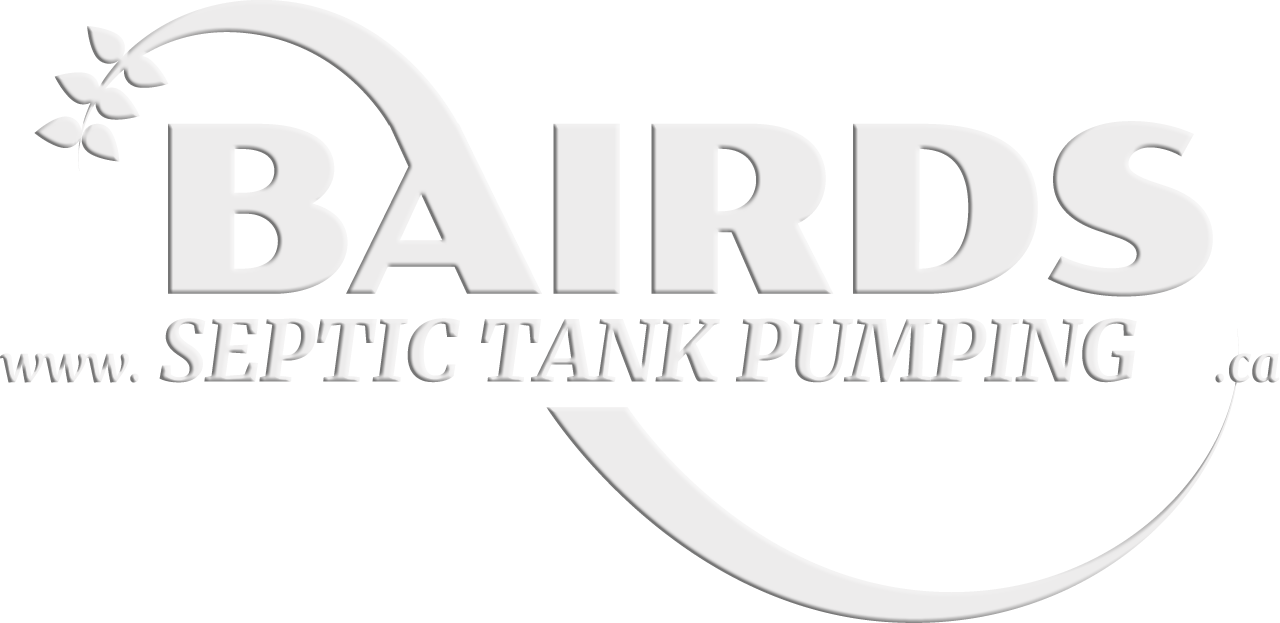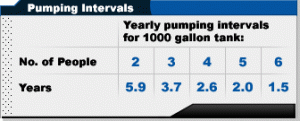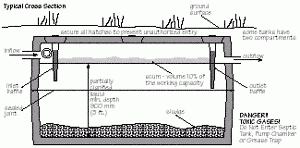Have a question for Baird’s Septic?
With over thirty years experience, we know a thing or two about caring for your septic system. You can find answers to many of your most pressing questions below.Understand Your Septic System
On-site septic systems are generally cheaper to install and maintain than central services, but they do require more care and attention by the owner. When properly installed and looked after, on-site systems can reliably dispose of household sewage in a way that will protect your water supply, public health, and the environment.

Basic Septic System Design
The septic tank is a watertight box made of precast concrete, reinforced fiberglass, or plastic placed between the house and a disposal field. The tank protects the disposal field by containing solids and grease so that they do not reach the disposal field.
When household waste enters the tank, several thing occur.
- Lighter solids and materials float to the surface of the tank to form a layer called scum.
- Heavier solids and the by-products of biological digestion settle to the bottom of the tank to form a layer called sludge.
- Liquid from the clear space passes out to the disposal field to be treated by the soil. If solids are able to pass through the septic tank to the disposal field the pores in the soil will become clogged, causing a bed failure.
Common Questions About the System
How often should the septic tank be pumped?
What is a riser?
How many covers are on my tank and which one should be exposed?
Will Baird’s Septic locate and dig up my tank cover for me?
I want to have the tank pumped but I don’t know where it is?
I have a stand pipe, will you pump through it?
Knowing the Signs and Avoiding Problems
What are some warning signs of a failing septic system?
- Plumbing backups
- Sluggish drainage in the house
- New gurgling noises in the pipes and drains
- Soft ground or greener grass in the area of the septic field
- Surface breakout of sewage around disposal bed
What are some common causes for failure?
- Lack of understanding on the proper use of the system
- Poor soil conditions and/or faulty design or installation
- Over use-volume of water discharged exceeds system capabilities. I.e. more people in the house or leaky faucet
- Unusually high water table, flooding the tank and/or the bed
- Tree roots clogging pipes
- Traffic over the disposal field breaking pipes
- Obstruction in the pipe between the house and the septic tank
Is there anything I can do to help keep my tank and field working properly, such as using additives?
What Else Can I Do To Make My System Work Better?
- Check and fix or replace leaking or slow-draining plumbing fixtures regularly. Call a plumber if you cannot find the problem yourself.
- Spread out water use: do laundry (full loads) once a day or over the week rather than partial loads or several loads a day. Do dishwashing when the machine is full and spread out the loads. Use water-saving machines.
- When guests or parties will produce an extra load on the system, pump tank before guests arrive. Use off-site facilities for excess laundry. Consider a timed-dose system. If the extra load is regular, you may need to expand the system.
- Reduce normal water use in showers and sinks: take short showers and turn off the water while brushing teeth.
- Use heat tape to prevent freezing of pipes rather than running water continuously.
- Install water conserving fixtures, such as low-flow showerheads and ultra-low flush toilets.
- Make sure that the septic tank is watertight so groundwater does not leak into it.
- Make sure that the system is located and protected to avoid unnecessary extra water from groundwater, surface water, roof and foundation drains, interceptor drains, sumps, treatment unit backwash, and other sources.
Do I Need To Know Anything About Disposal Field Care?
It is important not to cover the field with a hard surface, such as concrete or asphalt or heavy clay material. Vehicles (cars, machinery, ATVs, snowmobiles) must NOT be allowed to run over any part of a disposal field since soil compaction, crushed distribution pipes, and damage to the field can result. Don’t stack wood or build a shed or raised garden over your disposal system. The soil needs to breathe.
For trouble-free operation, you should also control how much water you use and what goes down the drain.
Why and How Should I Conserve Water?
- The excess flow can wash out solids from the septic tank before they are treated or removed, damaging or clogging the disposal field.
- If excess flow is more than the field can disperse, the ground surface or your plumbing system, may flood.
- Conserving water will extend the life of your system.
We all let things in our lives get backed up from time to time.
Don’t Let Your Septic System Be One Of Them!
What Should I do if a Problem Occurs?
Keep a file folder readily available with a diagram of the system location, approval, and certificate of installation. If you cannot find your records, the Department of Environment may have a copy of the approvals. If no records are available, start your own file.
Problems are generally seen in a couple of ways. Either the sewage backs up into the household plumbing, OR, wet spots appear on top of the ground. Troubleshooting usually begins in the house and proceeds towards the disposal field.
The House and Sewer Line
If these simple measures do not work, hire a certified plumber to check for a physical blockage in the house. Common culprits include rags, diapers, children’s toys, plastic bottles, and a combination of congealed grease and lint from the washing machine.
If there is no blockage in the house, the next step is to check the building sewer line between the house and the tank. Common problems in the line include the culprits listed above, frost heave and settling, and broken pipe. Frost heave and settling may have altered the original slope on the sewer line, creating low spots where liquid can puddle and freeze during the winter months. This results in partial restriction or blockage. Alternatively, the pipe may have broken off completely due to settling after installation.
The Tank
If pumping the tank does not solve the problem for more than a few days, or if raw sewage is discharging, the problem is likely in the disposal field. If pools of water are noticed in the field area, use water sparingly for a few days and check for improved performance.
The Field
Increase in water load can result from:
-
Using fixtures such as hot tubs, jacuzzis, and spas.
-
Concentrating water use, such as multiple washes in one day.
-
Increasing family numbers or entertaining groups or visitors
-
Leaking plumbing fixtures.
-
Running faucets to prevent freezing of pipes.
-
Piping sink and laundry wastes directly to the field and bypassing the tank.
-
Directing water from roofs, driveways, and foundation drains into the system.
-
Flooding by high groundwater table seasonally.
-
Overloading of part of the field with water, due to too much or too little slope within the field, or ponding and infiltration of surface water over part of the field.
-
Poor design (Too small for the flow).
If you have an emergency, such as sewage backing up into the house, and you cannot fix it yourself, call a certified installer. Depending on the specific cause(s) of your problem, you may need a qualified professional involved to make further repairs or changes to the existing system, or to select/design a new system. You can also contact the nearest Department of Environment office for advice on how to solve the problem.
An Ounce of Prevention is Worth a Pound of Cure!
Here are a few quick Do’s and Don’ts to ensure your septic system stays healthy and lasts for a long time.
Do's
- Do have your septic tank pumped out regularly.
- Do spread automatic washer use over the week rather than many loads on one day.
- Do make a permanent record of where the key parts of your system are located for future maintenance, such as tank pump outs or field repairs.
- Do keep records of pump outs and maintenance.
- Do use water conserving devices where possible. Low flush toilets and shower heads are commonly available.
- Do have manually cleaned lint traps on your automatic washer.
- Do check any pumps, siphons, or other moving parts of your system regularly.
- Do remove or prevent trees with large root systems growing near the disposal field.
- Do maintain a healthy grass cover over the disposal field to use some of the water and to prevent erosion.
- Do keep surface water from upslope or from roof drains away from the disposal field.
- Do compost your kitchen waste.
Don'ts
- Don’t overload the system with high volumes of water.
- Don’t connect basement sump pumps to the on-site system.
- Don’t connect backwash from water treatment devices directly to the on-site system without professional advice.
- Don’t allow large amounts of fats, chemicals, or solvents to enter the system; don’t allow any plastics to enter.
- Don’t rely on septic tank additives. Although beneficial for bacterial growth, it will not eliminate the need for regular septic tank pumping.
- Don’t enter a septic tank without proper ventilation, a second person (adult) above ground, and other requirements of the Department of Labour for confined spaces. Sewer gases can be fatal.
- Don’t allow vehicles or heavy equipment to drive over or park on the disposal field. This may compact the soil and crush the piping.
- Don’t plant anything over the disposal field except grass; especially, don’t cover the tank or field with asphalt or concrete or other impermeable material.
- Don’t put in a separate pipe to carry wash waters to a side ditch or woods. These ‘greywaters’ also contain disease carrying organisms
- Don’t wait for signs of failure. Check the system regularly.
- Don’t flush:
- coffee grounds – dental floss – paints
- disposable diapers – kitty litter – varnishes
- sanitary napkins – tampons – waste oils
- cigarette butts – condoms – poisons
- fats, grease and oils – paper towels – thinners
- disinfectants – pesticides
- photographic chemicals – other chemical wastes.


